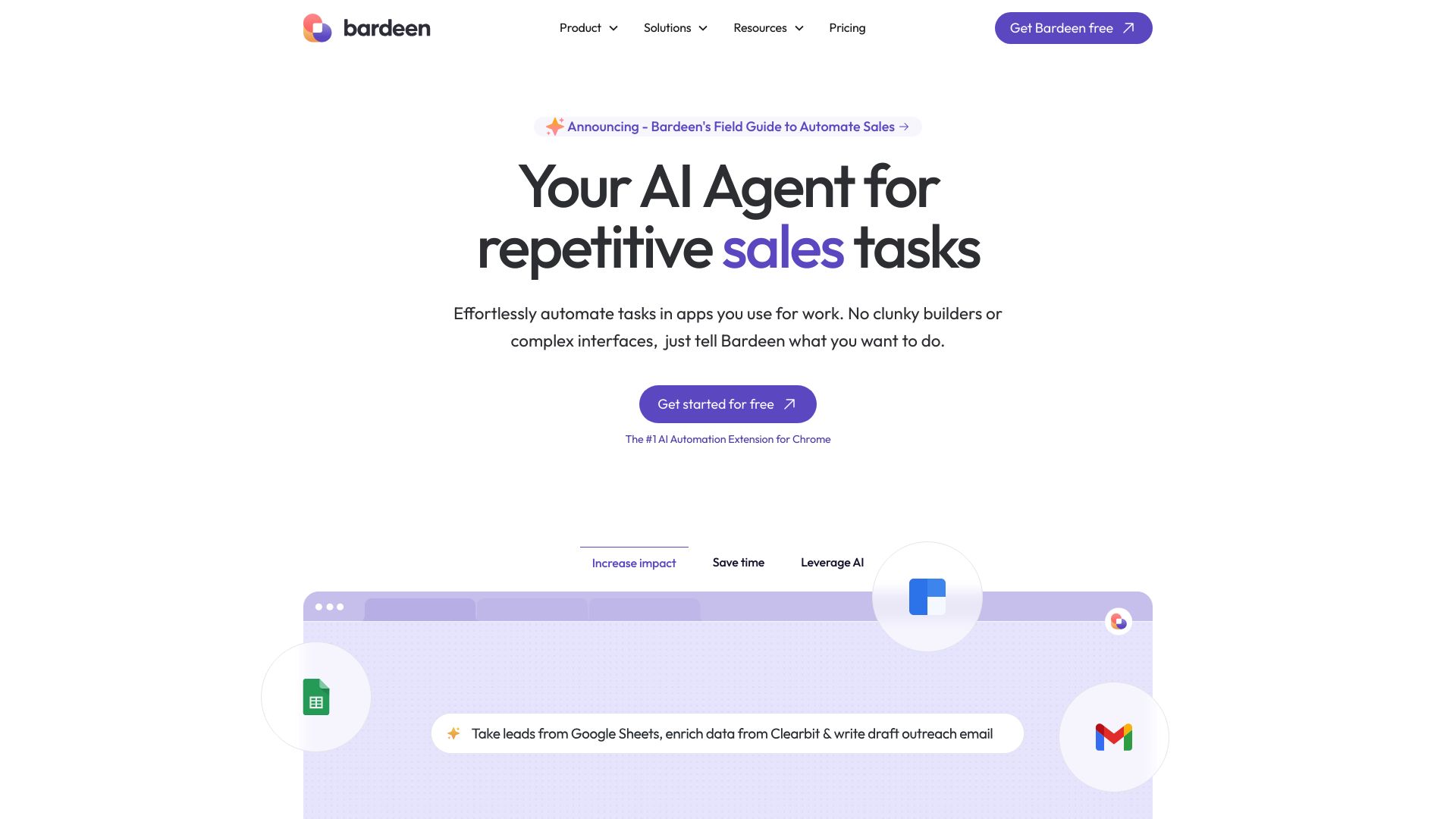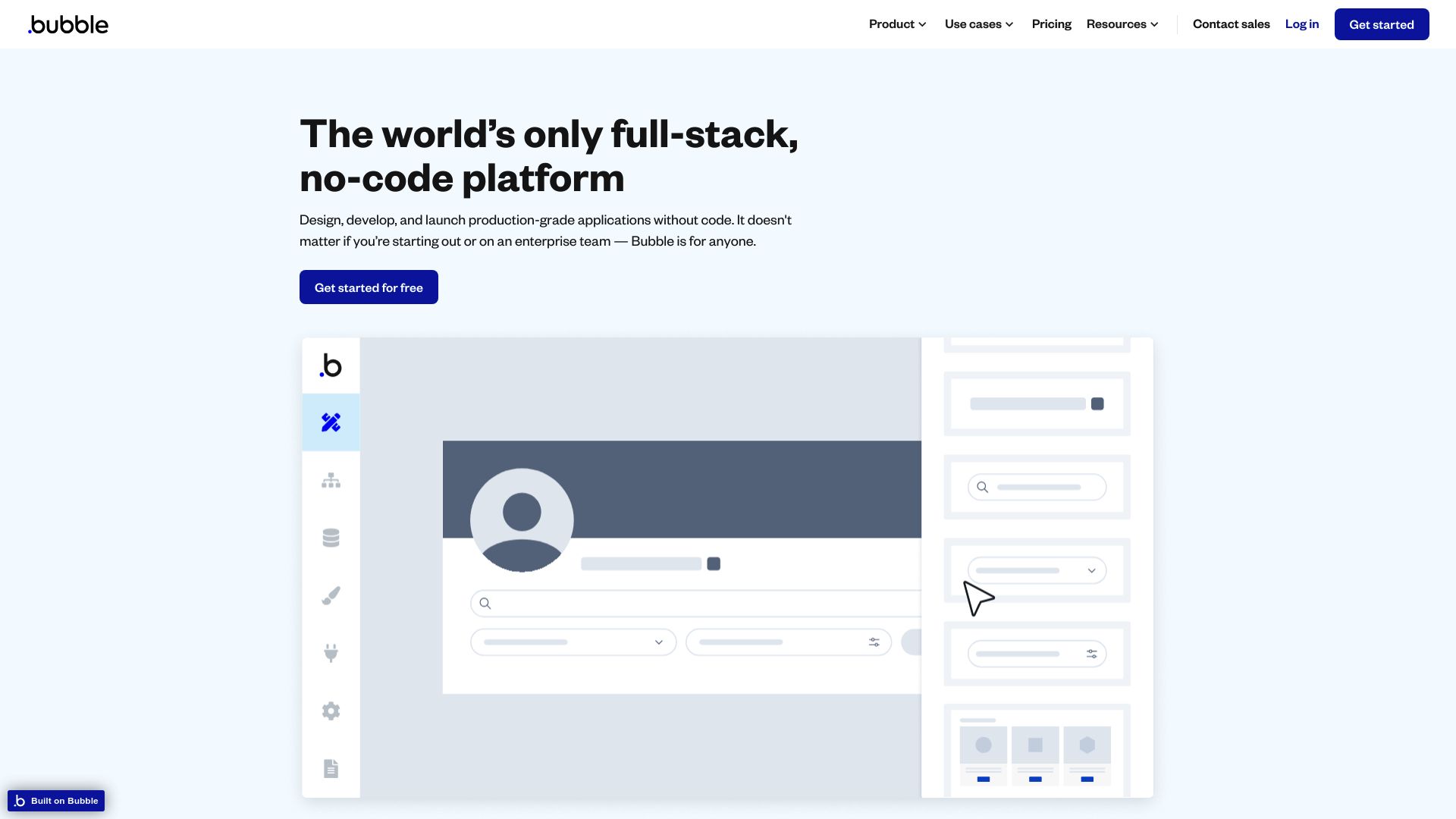Bardeen AI vs. Bubble: Comparing Browser Automation and No-Code Development
AI-driven software development and automation tools transform how businesses operate in today’s digital landscape. This comparison explores Bardeen AI vs. Bubble, and SmythOS, three platforms reshaping the industry. Bardeen AI specializes in browser-based task automation, Bubble offers comprehensive no-code web application development, while SmythOS elevates AI integration to new heights.
We’ll examine their unique features, strengths, and limitations to help you choose the right solution for your needs. Whether you’re a developer seeking advanced AI capabilities, a business leader focused on scalability, or an entrepreneur looking for accessible tools, this analysis provides valuable insights into these cutting-edge platforms.
Bardeen AI Overview
Bardeen AI offers a no-code web automation platform designed to streamline repetitive tasks through a Chrome browser extension. The platform empowers users to create custom workflows called Playbooks without coding expertise, leveraging AI to enhance automation capabilities.


Bardeen’s visual builder allows users to construct automations by dragging and dropping pre-built actions and triggers for popular applications like Gmail, Google Sheets, and LinkedIn. The platform incorporates AI-powered features such as text classification, data extraction, and text generation, utilizing models like GPT-3 to augment its capabilities.
Bardeen’s visual builder allows users to construct automations by dragging and dropping pre-built actions and triggers for popular applications like Gmail, Google Sheets, and LinkedIn.
A key strength of Bardeen lies in its human-in-the-loop approach, where users can actively guide automations, validate data, and provide inputs as needed. This participative automation model sets Bardeen apart, allowing for more personalized and context-aware workflows. The platform also offers AI Classifier and Personalized AI Actions, further enhancing its intelligent automation capabilities.
A key strength of Bardeen lies in its human-in-the-loop approach, where users can actively guide automations, validate data, and provide inputs as needed.
However, Bardeen has limitations. It lacks features like hosted autonomous agents, separate development and production environments, and advanced debugging tools. The platform primarily focuses on browser-based robotic process automation (RPA) with human oversight, which may not suit use cases requiring fully hands-off automation or complex enterprise-wide orchestration.
Bardeen integrates with various applications and services, including OpenAI and Zapier, expanding its functionality and allowing access to a wide range of APIs. The platform supports collaborative workspaces and team-wide automations, making it suitable for small to medium-sized teams looking to improve productivity through automated workflows.
While Bardeen excels in democratizing automation for users without coding expertise, it may fall short for those seeking more advanced AI agent capabilities, such as multi-agent collaboration or extensive problem-solving beyond pre-defined templates. Its strength lies in enabling personalized, human-guided automations rather than fully autonomous AI agents.
Bubble Overview
Bubble empowers users to build web applications without coding. The platform’s visual interface allows dragging and dropping elements to create fully functional apps, opening up development to non-technical users.
Bubble’s no-code approach democratizes software creation, enabling entrepreneurs, business professionals, and aspiring developers to bring their ideas to life. Users can craft complex applications with databases, workflows, and responsive designs through an intuitive visual editor. The platform supports integration with popular services and APIs, extending functionality beyond its built-in features.
Bubble’s no-code approach democratizes software creation, enabling entrepreneurs, business professionals, and aspiring developers to bring their ideas to life.


One of Bubble’s standout features is its AI integration capabilities. Users can incorporate advanced AI functionalities like chatbots, content generation, and image processing into their applications through plugins and API connectors. This allows for the creation of sophisticated AI-powered apps without requiring deep technical expertise in artificial intelligence.
Users can incorporate advanced AI functionalities… into their applications through plugins and API connectors.
While Bubble offers powerful features for app creation, it may have limitations for highly complex or specialized applications that require fine-grained control over code. Performance can also be a concern for apps with very high traffic or data-intensive operations. Additionally, the learning curve for utilizing Bubble’s full potential can be steep for users accustomed to traditional coding environments.
Bubble’s scalability and security features make it suitable for both small projects and enterprise-level applications. Built on Amazon Web Services, it provides robust infrastructure with GDPR compliance and SOC 2 Type II certification. The platform also offers real-time collaboration tools and version control, facilitating teamwork in app development.
Feature Comparison
Bardeen AI and Bubble offer distinct approaches to software development and automation. Bardeen AI specializes in browser-based automation through its Chrome extension, focusing on streamlining repetitive web tasks. Bubble, on the other hand, provides a comprehensive no-code platform for building full web applications.
Bardeen AI excels in creating automated workflows called Playbooks using a visual builder. It leverages AI for tasks like text classification and data extraction. However, Bardeen lacks features for hosting autonomous agents or separate development and production environments. Its strength lies in human-guided automation rather than fully autonomous AI agents.
Bubble offers a more versatile platform for building complex web applications without coding. It provides a visual interface for creating databases, workflows, and responsive designs. Bubble supports AI integration through plugins and API connectors, allowing users to incorporate chatbots and other AI functionalities. Unlike Bardeen, Bubble focuses on comprehensive app development rather than specific task automation.
In terms of security, both platforms prioritize data protection. Bardeen secures data in the browser’s storage and cache layers, while Bubble offers robust infrastructure with GDPR compliance and SOC 2 Type II certification. However, Bubble provides more advanced scalability features, making it suitable for both small projects and enterprise-level applications.
While both platforms offer visual builders and no-code options, they differ significantly in their core focus and capabilities. Bardeen AI targets specific web-based task automation, whereas Bubble enables the creation of full-fledged web applications with more extensive customization options.
| Bardeen AI | Bubble | SmythOS | |
|---|---|---|---|
| CORE FEATURES | |||
| Memory & Context | ❌ | ❌ | ✅ |
| Autonomous Agents | ❌ | ❌ | ✅ |
| Explainability & Transparency | ✅ | ❌ | ✅ |
| Debug Tools | ❌ | ✅ | ✅ |
| Multimodal | ❌ | ❌ | ✅ |
| Problem-Solving Capabilities | ❌ | ✅ | ✅ |
| Multi-Agent Collaboration | ❌ | ❌ | ✅ |
| Audit Logs for Analytics | ❌ | ✅ | ✅ |
| Bulk Work | ✅ | ❌ | ✅ |
| Agent Work Scheduler | ✅ | ❌ | ✅ |
| SECURITY | |||
| Constrained Alignment | ❌ | ❌ | ✅ |
| IP Control | ❌ | ❌ | ✅ |
| COMPONENTS | |||
| Foundation AIs | ❌ | ✅ | ✅ |
| Huggingface AIs | ❌ | ❌ | ✅ |
| Zapier APIs | ❌ | ✅ | ✅ |
| Classifiers | ✅ | ❌ | ✅ |
| Logic | ❌ | ✅ | ✅ |
| Data Lakes | ❌ | ✅ | ✅ |
| DEPLOYMENT OPTIONS (EMBODIMENTS) | |||
| Deploy as API | ❌ | ❌ | ✅ |
| Deploy as Webhook | ❌ | ✅ | ✅ |
| Staging Domains | ❌ | ✅ | ✅ |
| Production Domains | ❌ | ✅ | ✅ |
| API Authentication (OAuth + Key) | ❌ | ✅ | ✅ |
| Deploy as Site Chat | ❌ | ✅ | ✅ |
| Deploy as Scheduled Agent | ✅ | ❌ | ✅ |
| Deploy as GPT | ❌ | ✅ | ✅ |
| DATA LAKE SUPPORT | |||
| Hosted Vector Database | ❌ | ❌ | ✅ |
| Sitemap Crawler | ❌ | ❌ | ✅ |
| YouTube Transcript Crawler | ✅ | ❌ | ✅ |
| URL Crawler | ❌ | ❌ | ✅ |
| Word File Support | ❌ | ✅ | ✅ |
| TXT File Support | ❌ | ✅ | ✅ |
Best Alternative to Bardeen AI and Bubble
SmythOS stands out as the superior alternative to Bardeen AI and Bubble, offering a comprehensive agentic AI automation platform that combines powerful features with unparalleled ease of use. We provide a versatile solution for creating, deploying, and managing AI agents across various use cases.
Our visual builder and no-code options make AI development accessible to users of all skill levels, from beginners to experienced developers. Unlike Bardeen AI’s limited browser-based automation or Bubble’s focus on web app creation, SmythOS enables the development of sophisticated AI agents capable of autonomous operation and multi-agent collaboration.
SmythOS enables the development of sophisticated AI agents capable of autonomous operation and multi-agent collaboration.
We offer robust memory and context capabilities, ensuring AI agents maintain coherent interactions over time. This feature, absent in both Bardeen AI and Bubble, allows for more intelligent and context-aware automations. Our platform also excels in problem-solving capabilities, multimodal interactions, and advanced debugging tools, surpassing the limited offerings of our competitors.
SmythOS provides unmatched flexibility in deployment options. Users can deploy AI agents as APIs, webhooks, scheduled tasks, or integrate them into existing applications. This versatility, combined with our scalable infrastructure, makes SmythOS ideal for projects of any size — from individual automations to enterprise-wide AI solutions.
SmythOS provides unmatched flexibility in deployment options. Users can deploy AI agents as APIs, webhooks, scheduled tasks, or integrate them into existing applications.
By choosing SmythOS, users gain access to a powerful, user-friendly platform that outperforms Bardeen AI and Bubble in key areas of AI agent development and deployment. Our comprehensive feature set, coupled with unlimited use cases, positions SmythOS as the premier choice for those seeking to harness the full potential of AI automation.
Conclusion
Bardeen AI and Bubble offer unique approaches to software development and automation, each with its own strengths. Bardeen AI excels in browser-based task automation, while Bubble provides a comprehensive no-code platform for building web applications. Both platforms democratize software creation, but SmythOS takes this concept to the next level.
SmythOS stands out with its advanced AI agent capabilities, extensive integration ecosystem, and versatile deployment options. Unlike Bardeen AI and Bubble, SmythOS offers hosted autonomous agents, separate development and production environments, and advanced debugging tools. Our platform supports multi-agent collaboration and problem-solving beyond pre-defined templates, making it ideal for complex, enterprise-level projects.
We’ve designed SmythOS to be the most comprehensive solution for AI-driven development. Our drag-and-drop interface, coupled with support for various AI models and APIs, allows users to create sophisticated AI workflows without extensive coding knowledge. This makes SmythOS suitable for a wide range of users, from developers and IT managers to non-technical professionals and AI enthusiasts.
Ready to experience the future of AI development? Create a free SmythOS account today and discover how our platform can transform your workflows and drive innovation in your organization. With SmythOS, you’re not just keeping up with AI advancements – you’re leading the charge.
Last updated:
Disclaimer: The information presented in this article is for general informational purposes only and is provided as is. While we strive to keep the content up-to-date and accurate, we make no representations or warranties of any kind, express or implied, about the completeness, accuracy, reliability, suitability, or availability of the information contained in this article.
Any reliance you place on such information is strictly at your own risk. We reserve the right to make additions, deletions, or modifications to the contents of this article at any time without prior notice.
In no event will we be liable for any loss or damage including without limitation, indirect or consequential loss or damage, or any loss or damage whatsoever arising from loss of data, profits, or any other loss not specified herein arising out of, or in connection with, the use of this article.
Despite our best efforts, this article may contain oversights, errors, or omissions. If you notice any inaccuracies or have concerns about the content, please report them through our content feedback form. Your input helps us maintain the quality and reliability of our information.
